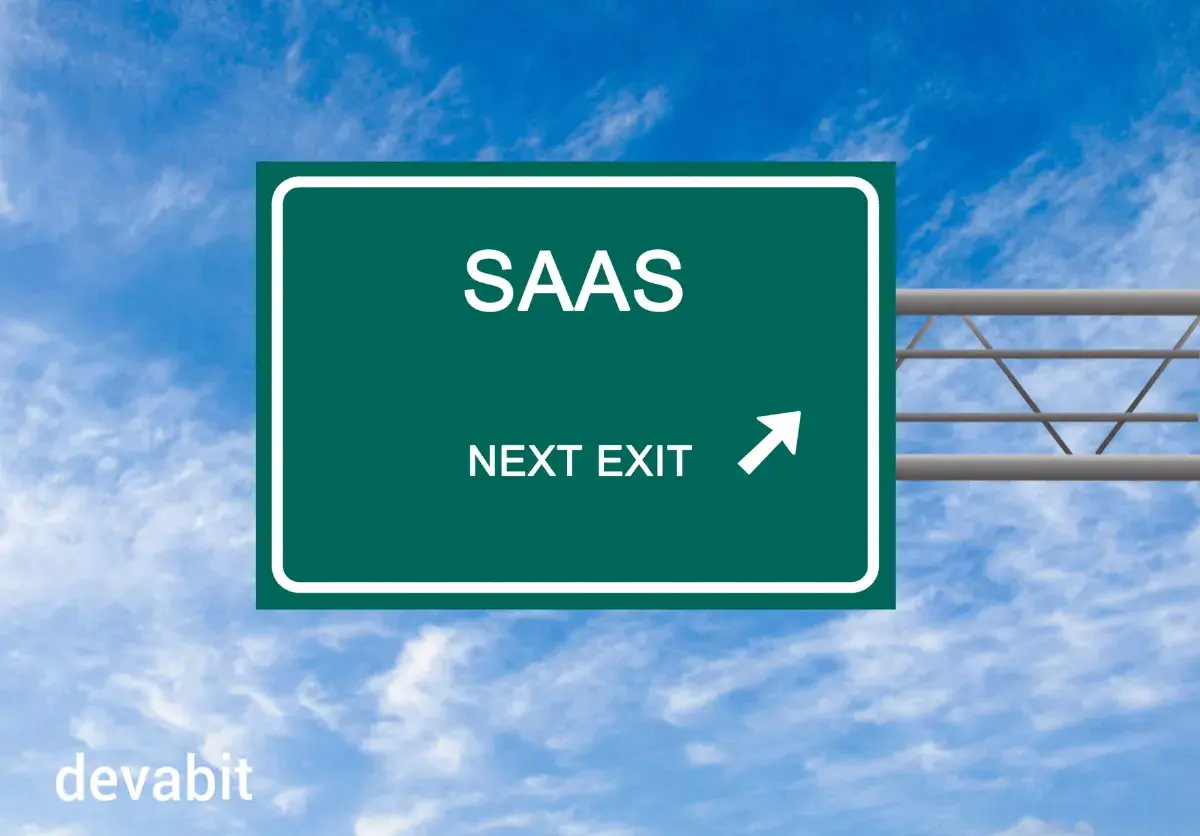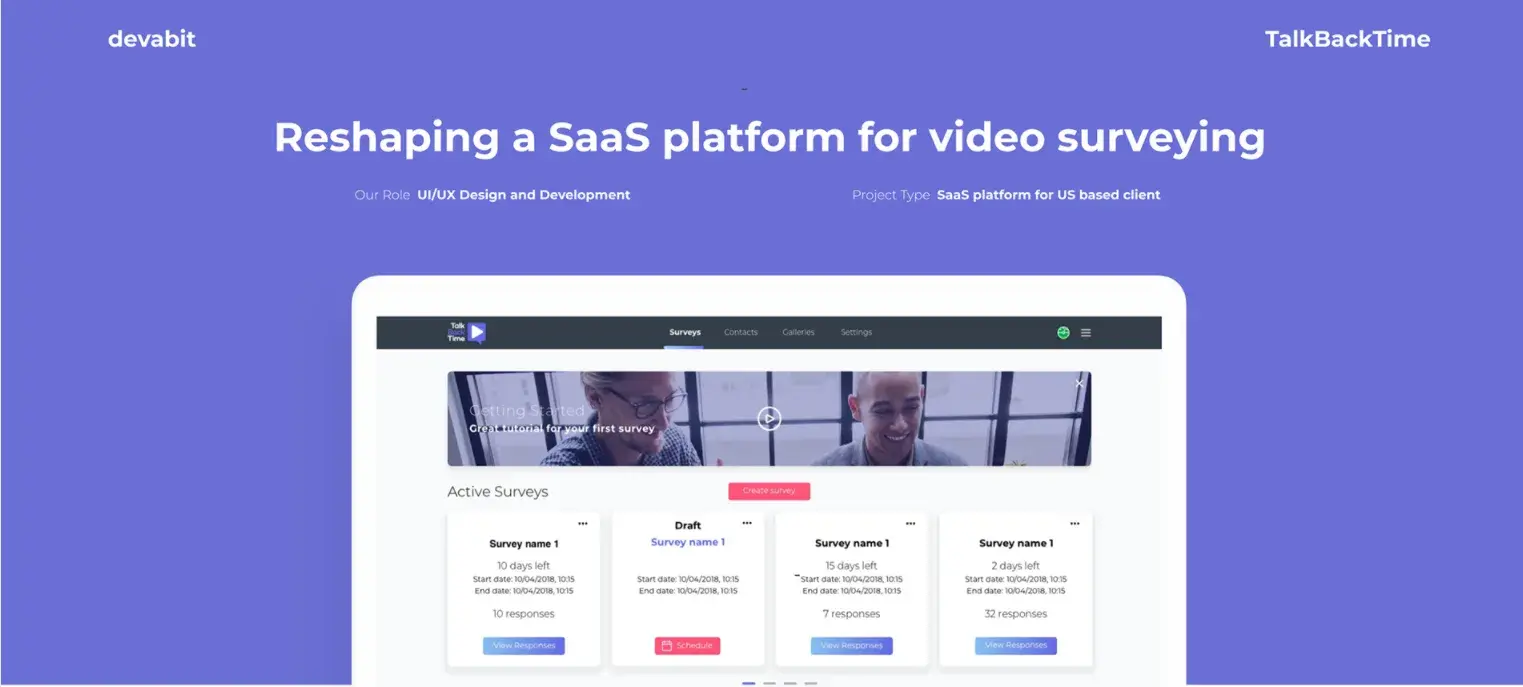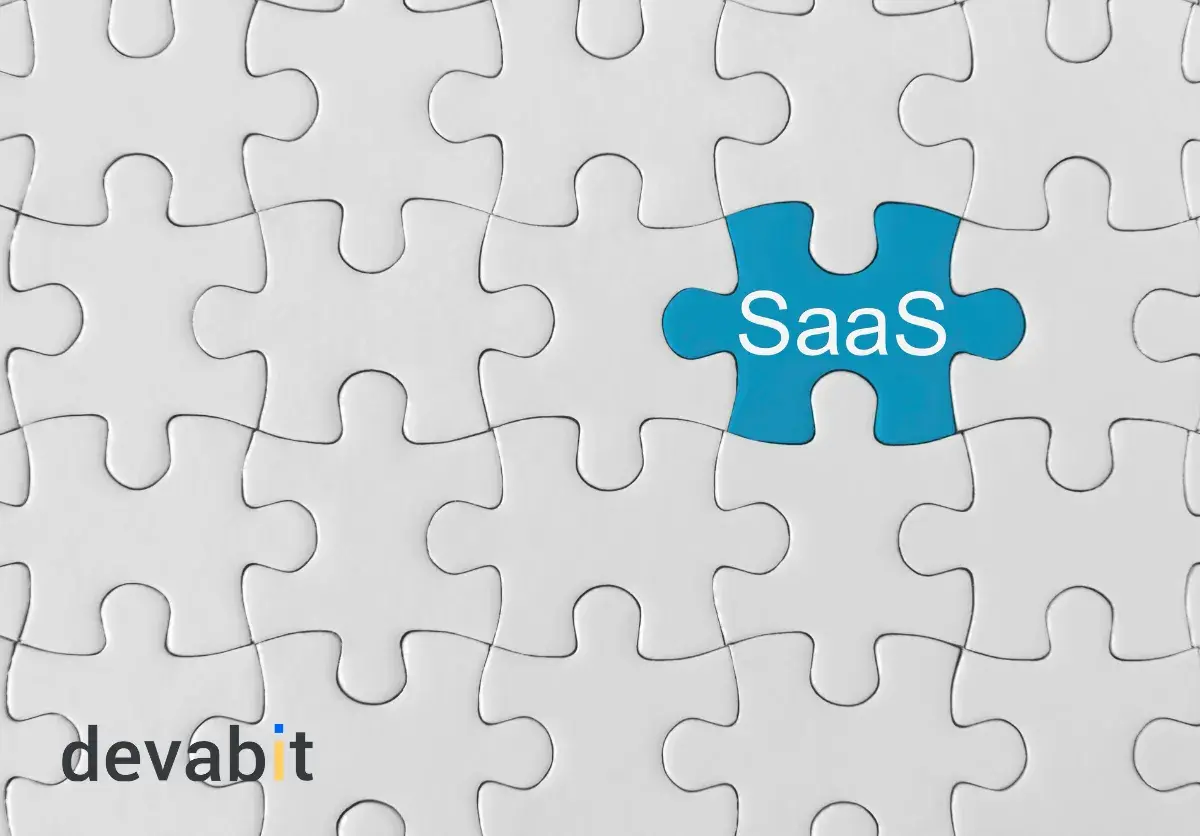Software as a Service: SaaS Defined in Simple Terms
Software as a service, mostly known as SaaS... Probably, this acronym wraps your head around. However, this concept is clearer than it may seem at first, and we are going to prove it today.
As one of the most popular cloud software distribution models, SaaS solutions are rapidly hijacking the global business market. Why? Well, the answer lies in the definition, benefits, and specificities of SaaS described in the following paragraphs. Let's have a quick look at the topics we are about to cover today:
- SaaS (Software as a Service) is a software delivery model where applications run on a provider’s cloud infrastructure and are accessed over the internet on a subscription basis, with the vendor handling hosting, maintenance, updates, security, and scalability.
- What are the most well-known SaaS examples? Popular SaaS examples include:
- Gmail
- Netflix
- TalkBackTime
- Google Workspace
- Zoom
- GitHub
- BigCommerce
- How can businesses benefit from SaaS adoption? Companies from any niche can vastly benefit from SaaS adoption in a few ways:
- Faster Time-to-Value;
- Elastic Scalability;
- Security & Compliance;
- Rich Integrations & Open APIs;
- High Availability & Disaster Recovery.
- TalkBackTime is a unique SaaS platform for video surveying. It covers a multitude of functions, ranging from targeted ad adjustments to job candidate screening. Being one of the prominent SaaS solution examples, devabit project demonstrates how wide the SaaS potential is. From the e-Learning industry to complex business operations.
- What are the pitfalls associated with SaaS adoption? When choosing SaaS for your business needs, you have to be ready to face such challenges as:
- You risk your data confidentiality if you cooperate with a suspicious or unproven SaaS provider;
- You operate less control over your data as the SaaS provider is the one who stores, processes, and transfers it;
- SaaS adoption requires a stable Internet connection and may affect your data if you struggle to provide one.
- 84% of IT & telecommunications executives said that adopting SaaS has improved security in their organisations.
- The global SaaS market is projected to grow from ~$315.7B in 2025 to ~$1.13T by 2032 (≈ 20% CAGR over 2025–2032).
Therefore, if you are new to the software as a service world, you are at the right place and at the right time. In this article, you'll find out what SaaS is and what it can do for your company, identify the benefits and pitfalls of SaaS, and understand why SaaS is a necessity for future-oriented businesses.

- What Is SaaS in Simple Terms?
- Software as a Service (SaaS) in Numbers
- SaaS Market in the Course of Time: What to Expect?
- Software as a Service (SaaS) Platform and... Renting? Revealing the Connection
- Examples Are Better than Words or Why Software as a Service (SaaS) Is More Widespread than You May Think
- SaaS Defined Through Real Cases Instead of Boring Phrases: 'TalkBackTime'
- SaaS Defined Through Features that Can Benefit Your Company
- The Dark Side of SaaS Solutions for Businesses and How to Manage Them
- Final Verdict
What Is SaaS in Simple Terms?
SaaS Defined: SaaS stands for a way of delivering applications over the Internet. In other words, it's like a service that helps you access the software online. You do not have to maintain or install the system, while you also aren't responsible for complex software and hardware management. Just pay and use, what can be easier?
Notably, a modern cloud provides comprehensive software for your entire business so that you can subscribe to specific SaaS applications as required. Accounting, marketing, HR, sales, supply chain — everything is at hand whenever it's needed.
Hosted software, on-demand software, or even web-based software, SaaS is associated with different titles, but the context remains the same. SaaS providers' servers host all the applications. That's why the provider manages the availability and performance of SaaS apps. Summing up, what is SaaS in simple words? SaaS meaning revolves around delivering software over the internet: you use applications hosted online instead of installing them on your PC.

Who Can Benefit from SaaS Adoption?
Almost every company delivering services across numerous industries, from the Automotive and Healthcare to Fintech and E-Learning, can benefit from Software as a Service development. But why? It is as simple as that. Software as a service exempts the company from building and maintaining costly hardware, but instead offers storing and processing their large data on demand, enabling them to pay only for the actual amount of resources used. This way, the company not only saves the budget and time required for hardware building but also receives a scalable and ready-to-go solution designed to meet their specific business needs.
In the case with professional service firms, SaaS is a real game-changer, and here is why:
- Secure document/knowledge management via a Software as a Service platform turns one firm’s best work into every team’s starting point.
- Branded client portals with e-sign, secure file exchange, and real-time status updates cut email ping-pong and increase transparency. Cannot be easier with SaaS.
- Stronger compliance & security. Built-in retention policies, audit trails, DLP, SSO/MFA, and regional data residency keep firms aligned with ISO/SOC, GDPR/CCPA, and industry rules.
- AI as a secret weapon. Research assistants, first-draft generators, meeting summarizers, and auto-tagging for workpapers help juniors produce more, seniors review faster, and clients get value sooner.
And that is only the peak of the SaaS opportunities for professional service firms' iceberg. If you want to truly dive deep into the successful strategy of a Software as a Service integration into the professional service firm workflow — check our detailed description of the SaaS potential for industry-specific businesses below.
Software as a Service (SaaS) in Numbers
There's no doubt that statistics speak louder than words. After all, when people want to determine the effectiveness of a particular approach or solution, they always turn to practical insights supported by analytical data. So, returning to the subject of the conversation, we've also prepared a brief statistical report based on relevant data resources.

Data taken from Statista
SaaS Market in the Course of Time: What to Expect?
Why do people utilize innovations? Most people will probably answer that innovations are necessary for building something new and designing tools that ease our lives. That's definitely the correct description, but not a complete one. First and foremost, innovation is about intelligently utilizing resources to find creative solutions for complex problems, and SaaS undeniably refers to such a kind of innovation. Although the SaaS platform may not always be the universal solution for everyone, it would be a mistake not to take a moment to consider this rapidly growing technology because it has truly promising perspectives ahead.
Post-COVID Technology Ecosystem as a Fundament for Development
It's not a secret that the global pandemic has significantly impacted all areas of human existence, so SaaS isn't an exception. An opportunity or a burden? Rather, a new wave of popularity. The two pivotal factors that contribute to SaaS growth in 2025 and beyond are:
- COVID's challenge: modern businesses are sticking to a fully remote work model. SaaS solution: cloud-based software is the best option for remote access.
- COVID's challenge: many companies are impacted financially by the pandemic. SaaS solution: compared to a traditional on-premise model, a cloud-based solution proposes a much lower entry investment.
How can we forget about the COVID-19 impact on the Healthcare industry itself? Ever since the first patient reported about strange, yet unknown, symptoms bothering them, the world has never been the same. Just as medical care.
New challenges made people worldwide adapt, and healthcare and medical software development experts are no exception. And here comes the Software as a Service solution — the hero holding the web front, while the medical heroes save the lives. But what does SaaS have to do with the healthcare industry? Awesome question! Let's crack it real quick and have a look at a few factors that led to the spread of SaaS-based solutions for medical needs:
- The rapid growth of the popularity of virtual care solutions associated with self-isolation choices, disease spread risk, and the predominance of online services.
- The new generation of younger Millennials and older ones of Gen Z preferring virtual care over a physical doctor visit.
- Electronic Health Record (EHR) systems gaining popularity due to patient data security, advanced analysis, and human error minimization.
- AI features in healthcare web solutions creating a huge advantage for those medical institutions that are ready to offer unique services over those that aren't.
Summing up, COVID-19 not only changed the way we treat social interactions, education, or patient treatment but also almost fully digitalized the healthcare industry worldwide. And a Software as a Service-based solution is a perfect choice for medical institutions or private healthcare service providers to store, analyze, and process huge patient data for providing top-notch virtual care. From telemedicine options and customizable patient profiles to the best compliance practices — these are the uncharted landscapes of the healthcare SaaS development opportunities.
devabit experts have equipped a complete guide to a successful healthcare SaaS solution development with must-have features, the latest industry trends, and cost-saving tips for those who seek to build the Software as a Service platform in 2025. Click below to become the next leader of the medical SaaS niche.
Clock is Ticking. Technology is Evolving
Nowadays, it's essential to recognize that the future of SaaS doesn't tend to slow down. As we've already sorted out, this cloud-based service gains more and more users every day. That's why such an extremely high demand evokes new transformations. It's logical to suppose that the SaaS model will continue to evolve in the future because businesses will require improved functionality, for instance:
- even greater flexibility;
- more effective onboarding and support services;
- upgraded functionality;
The innovations this growth tendency produces will be the story for cloud-based software in the current year and further. The global SaaS market is projected to grow from ~$315.7B in 2025 to ~$1.13T by 2032 with over 20% CAGR over 2025–2032). In this regard, it's logical to conclude that SaaS is nearly everywhere, so implementing cloud-based solutions for your business will help you stay on trend.
Another sector that has been grasping investors' attention lately and is projected to continue the trend of Software as a Service growth is the Automotive SaaS development. Yes, Software as a Service for car fans is the true winner of the web race. And needless to say, it is not going to stop.
What are we talking about? Remarkable driver-centric experiences with advanced data analysis features, predictive maintenance for vehicles, and agentic AI-driven cars, all empowered by the automotive Software as a Service. The automotive SaaS boom is no joke in 2025, and there are a few vital factors influencing this rapid shift.
First and foremost, mobility services are now at their most, and vehicle manufacturers cannot deny this. While the average driver age tends to reach its lowest, dealerships need more ideas on how to appeal to this new driver generation's demands.
While vehicles are becoming an item of status and personal comfort, rather than a necessity, Software as a Service is one of the safest options for digitalization of outstanding driver experiences. And in case you want to find out how SaaS revolutionizes the automotive industry, brings AI into every corner of your vehicle, and changes the rules of car maintenance, check our ultimate guide to the automotive SaaS of 2025. Do not miss the chance to win that race with devabit expertise.
Software as a Service (SaaS) Platform and... Renting? Revealing the Connection
SaaS is often mistakenly correlated with renting. Although these concepts truly have several common features, they're fundamentally different. After all, SaaS = Rent?
From a metaphorical standpoint, this equation makes sense because you have to pay a monthly, quarterly, or annual fee to use ('rent') the system. Just imagine that you're renting a furnished rental office, you pay the necessary fee, but there's nothing to own or maintain — the same with SaaS.
— But how do I choose a trusted SaaS provider? You may ask, and that would be more than a fair question.
When you have finally come to the decision to use SaaS services for your business, you might face a dead end of endless choices and uncertain decisions. Luckily for you, our team has gathered pro advice on how to choose the best SaaS provider for your unique needs and budget opportunities.
In our all-in guide, you will find:
- What questions should you ask yourself before opting for one SaaS candidate?
- How do you know when you need SaaS?
- How do you mitigate the risks associated with SaaS development?
- What criteria should you consider when choosing a reliable SaaS provider?
- How do you ensure the security of your SaaS-based solution?
- How do you avoid the cooperation pitfalls?
- Which pricing models are best for SaaS building?
And even more must-ask questions and upright answers to help you choose a solid SaaS provider that will not only share your unique vision and needs but also ensure service security, future-proofness, and robustness.
On the flip side, software arrangements, including SaaS, are not a lease because immaterial assets are precluded from rental accounting. Thus, SaaS shouldn't be defined by the periodization and type of payment, so let's move on to the more precise technical definitions.

Examples Are Better than Words or Why Software as a Service (SaaS) Is More Widespread than You May Think
When we consume this or that service, not as installed software, we become SaaS consumers already at that moment. The simplest cloud software delivery service that everyone uses is an email service, for instance, Gmail. Surprised? Then, let us surprise you even harder. Read on and explore the overwhelming difference between managing the work of email from scratch and using SaaS.
To organize the work of email yourself, you must:
- First, configure the server.
- Next, install specialized software on it (mail transfer agent, for example, Postfix), configure all this, and service it in the future.
- Then, it's necessary to install and configure an email client on your computer (open-source mail manager, for example, Thunderbird).
- Of course, the above-mentioned steps aren't a limit because all aspects should be constantly monitored to ensure that other mail servers don't ban/blocklist yours.
- At the same time, you shouldn't forget about fighting spam.
All in all, these five points represent only a tiny part of the actions you'll have to do in order to organize your email correctly. Such a type of mail server should be served by a full-time system administrator, or even a whole team of specialists, depending on the size and infrastructure of the particular organization.

In contrast, there's no need to host your own email server when you utilize a SaaS-powered solution like Gmail. How is it possible? Well, everything is quite simple: Google hosts the server, so all you have to do is access it through your browser-as-client. There's no time-consuming setup, configuration, or further management, so you can spend valuable time growing your business.
Gmail is just one example of a SaaS service that you can use. But have you ever thought of SaaS as a marketing tool, an educational platform, or even an environmentally conscious delivery-tracking solution? Cause devabit did!
Furthermore, our team has shaped these unique Software as a Service examples into one comprehensive overview to help you see SaaS as never before. In this article, we described four prominent Software as a Service examples from A to Z to help you broaden your software development horizons and fully comprehend the SaaS capabilities. Dive into the latest Software as a Service industry statistics, custom SaaS development insights, and top ideas for your next solution with devabit.
SaaS Defined Through Real Cases Instead of Boring Phrases: 'TalkBackTime'
In this section, we're thrilled to share our projects that perfectly represent the article's topic. Fortunately, TalkBackTime fits the context as this state-of-the-art SaaS solution aims at transforming the online surveying industry.
In a nutshell, TalkBackTime is a unique SaaS platform for video surveying. It covers a multitude of functions, ranging from targeted ads adjustment to job candidates screening. Yet, why is this platform worth your attention as a great example of the topic?
First, it's a custom solution that corresponds to the clients' corporate style and business needs, proving that SaaS could be adjusted to everyone. Second, it's easy to use and accessible on different devices. Finally, take a look at it instead of hundreds of words, and you'll understand what we intend to say. Just click here for more info — TalkBackTime.

SaaS Defined Through Features that Can Benefit Your Company
Vast Customization Capabilities
There's no doubt that the customizable nature refers to the most remarkable features of the SaaS platform. Each user can quickly adapt SaaS applications according to their business requirements without damaging the whole infrastructure.
Moreover, thanks to the unique SaaS architecture, all customizations are consistently preserved through upgrades. It follows that software providers can add upgrades more frequently, while adoption costs and customers risks will be significantly lower.
A Secure Multi-Tenant Platform
At first glance, this characteristic seems a bit controversial. Needless to say that multi-tenancy is an inevitable tribute to modernity. Yet, here comes the tricky area most users are concerned about — security. Is this multi-tenant platform safe enough? Yes, it is, so there are no reasons to worry because multi-tenant cloud services have higher security standards than standalone systems.
Let's draw an interesting parallel vis-à-vis the real-life case. Suppose you live in a single house with a fence around it. In theory, it should be much more secure than a flat in a block shared with numerous other households. Nevertheless, the practice shows that the householders in the apartment block will pool the expenditure of having a guard on duty 24/7 to monitor access to the building and control safety. Consequently, the multi-tenant cloud system is more secure, just like a shared house.
All these news terms seem a little confusing? No wonder! But the pathway to a successful and safe Software as a Service platform development lies through a lot more complicated terminology, long consultations, and experts who seem to speak a completely unknown language. Sounds tedious, doesn't it?
But not with devabit expertise. At our custom SaaS development company, we know what it takes for the client to conquer the uncharted peaks of Software as a Service. That is why our experts have gathered all the most frequently asked questions about the SaaS development strategy building into one straightforward guide to reaching the desired results in the shortest terms. In our article, you will find out:
- How to seamlessly integrate APIs into your SaaS platform?
- What is a vertical approach, and how does it enrich the Software as a Service development?
- How to safely migrate your existing data to the SaaS platform?
- Mobile or Desktop: what is best for your SaaS needs?
- How to transform your SaaS-based solution into a profitable ecosystem?
Follow the link to learn how we make complex things easy for our clients.
SaaS Solutions Are Time- and Cost-Effective
As Benjamin Franklin claimed over two centuries ago, "time is money." Still, this statement hasn't lost its meaning through the years, especially when it comes to the current state of business. Thankfully, SaaS solutions perfectly correspond to today's hectic lifestyle by saving both time and money.
In terms of cost, SaaS provides the following advantages:
- There's no need for additional hardware and middleware.
- SaaS apps operate on a subscription payment type, so there are no unpredictable expenses. Instead, you pay for what you use and simultaneously get the latest innovations and updates.
- Taking all of the above factors into account, it's clear that with lower costs for such top-quality software, your business's profits will be rapidly growing as a direct result.
Concerning time-saving capabilities, SaaS is associated with such features:
- The vendor is responsible for the complete maintenance of the software. Hence, it eliminates additional work hours and time that might have been required to upgrade the software.
- Instead of months dedicated to installing and maintaining the software, this software delivery model enables solutions that allow you to reduce the time-to-market period.
- Last but not least, SaaS apps are easy to use, which is why employees spend less time on learning. As a result, they adopt the system faster.

The Dark Side of SaaS Solutions for Businesses & How to Manage Them
Have you ever wondered about the way you perceive the business environment? Some people tend to be optimistic about any changes, which is great, but to a certain extent. Others have negative attitudes towards business innovations, and such a standpoint also has the right to exist when it comes to tricky decisions. Which approach is better? Both in the complex. As we've already clarified the key positive characteristics of on-demand software, it's time to identify the pitfalls. By the way, please note that these disadvantages aren't fatal because you can easily overcome them, and we'll show you how. Forewarned is forearmed, right?
SaaS Requires Stable Internet Connection
It's great that you can access the software wherever and whenever you need it via the Internet. However, this opportunity also poses several limitations: you'll always inevitably require a good Internet connection. In addition, network issues can lead to irritating download delays, which will damage productivity. Therefore, it would be better to prepare your office by taking care of the stable network connection in advance.
How do you deal with it? — To minimize potential downtime, consider a dual-connection setup: one main and one backup Internet provider. You can also use offline-friendly SaaS tools (for instance, Google Workspace or Notion with offline mode). For teams working remotely, implement a lightweight monitoring tool to track latency and connectivity quality in real time. It is a simple investment that prevents workflow disruptions.
Keep an Eye on Confidentiality
Although web-hosted software is typically considered a safe cloud-based solution, it also has some confidentiality concerns you should stay aware of. Your corporate data is usually kept on the provider's servers, so this fact may cause confidentiality concerns. To avoid this threat, it's necessary to create a prior agreement with the service provider documenting everything that could occur in case of any confidentiality issues.
How do you deal with it? — Before signing a contract, verify that your trusted SaaS vendor complies with data protection regulations (GDPR, ISO/IEC 27001, SOC 2, etc.). Always sign a Data Processing Agreement (DPA) clarifying ownership, access levels, and backup policies. These simple actions are the basis of your SaaS security and future-proofness.

Less Responsibility = Less Control
If business owners utilize in-house software applications, they automatically gain a high level of control. However, the situation is way different with SaaS applications because control belongs to a third-party provider. Of course, it isn't related to any adverse consequences, but some companies feel uncomfortable relying on someone else.
How do you deal with it? — Less control does not always mean negative consequences for you. How about considering SaaS outsourcing in cooperation with a proven custom SaaS development company that will ensure your solution's reliability and resistance to any challenges coming along, while you are free to focus on your core business objectives?
With a trusted SaaS outsourcing vendor, you have the opportunity to access:
- Professional custom cloud and SaaS development services for practically any business niche;
- Top-rated SaaS experts across the world working exclusively for your short- or long-term project;
- Complete control over the development and deployment process while being free of management and troubleshooting headaches;
- Unique and the most relevant tech stacks on the SaaS market, along with proven cybersecurity development practices;
- Flexible cooperation approaches matching your specific business needs, budget opportunities, and deadline requirements.
When choosing SaaS for your next project, you may face a few of the above-mentioned obstacles. But here comes the perfect-match solution. SaaS development outsourcing. Versatile cooperation and pricing approaches, faster and secure development, long-term partnership goals, and best cloud experts — all without tedious hiring, management, or endless fails and tries. Only polished and proven SaaS strategies.
If reading all of that made you think of the free time you could save, the costs you could reduce, and the new, unique ideas you might miss, it is the right time to consider SaaS development outsourcing services for your next project or ongoing development. And if you still hesitate whether outsourcing is the safest option specifically for you, check our SaaS outsourcing guide revealing its top benefits, hidden pitfalls, outsourcing vendor choice tips, and real project examples. See how outsourcing transforms great ideas into the greatest solutions.
Final Verdict
In the 21-st-century world, no one requires complexity, especially when it comes to business. Companies need robust tools capable of making their business performance easier, so the next-generation cloud software brings the required simplicity into their life.
After all, we hope that this article shed some much-needed perspective on this unique software delivery model. Do you need a custom solution that will work for the benefit of your business?
Then, don't pass on SaaS. Just drop us a line below, and we'll dispel all your doubts.
Recent Publications
Don't miss out! Click here to stay in touch.
Build SaaS with devabit

Relevant Articles View all categories
View all categories CONNECT WITH US WE’RE READY
TO TALK OPPORTUNITIES
THANK YOU! WE RECEIVED YOUR MESSAGE.
Sorry
something went wrong



